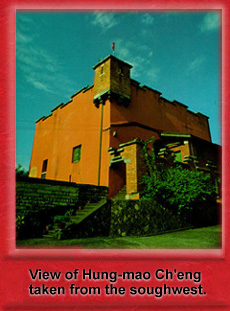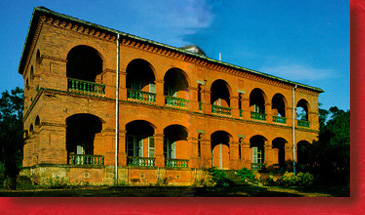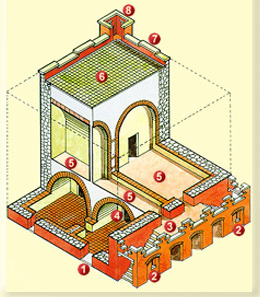


[ Construction Date ] 1629
Hung-mao Ch'eng, originally named Fort Santo Domingo, was built by the Spanish, but because it was later held by the Dutch, popularly know as 'the red-haired people' (hung-mao), it came to be known by its present name('the Fort of the Red-haired People').
The Spanish presence in Taiwan dates from 1626, when Fort San Salvador was built in keelung, in the extreme north of the island; the construction of Fort San Domingo, located in nearby Tamsui, followed in 1629. Both forts were in a position of mutual support. Itwas in 1642 that the Dutch attacked the north, drove out the Spanish and took possession of the forts. In 1661 the Dutch were expelled in turn by the armies of Koxinga(Cheng Ch'eng-kung), who then took over the forts. In1681 the fort was repaired by Koxinga's descendants, and an army was posted there. Two years later, in 1683, the island was brought under the administration of the Ch'ing government, and after that time the care of the site was neglected, until by the early eighteenth century it had grown quite dilapidated. Remnants of the original site were preserved thanks to a renovation carried out in 1724 by a local official. In 1860, as one of the provisions of the Tientsin Treaty, Tamsui became an open port, and in the following year the British opened a consulate there. In 1868, the consulate was moved to the present site. In March 1972, the British government closed its consulate in Tamsui, and the site was given to the charge of the Australian government; but, in December of the same year, Australia broke off diplomatic relations with the Republic of China. Britain then entrusted the charge of the site to the government of the United States. On June 30, 1980, ownership of the site was formally returned to the Republic of China.
The shape of the fort is square, and its red-bricked architecture creates an imposing appearance in the landscape. In front of the fort are four antiqe cannons dating from the early nineteenth century. The land within the fort is low-lying; a staircase leads to the roof, which can accommodate several hundred persons. Ruins of the old structure are a stirring sight.

This is the consulate built on this site by the British in 1891. A delicate and elegant brick edifice in thoroughly Western style, it was used both as workplace and living quarters for the consul and his staff. The semi-circular arches of the ground floor colonnade form a rhythmical contrast with the fully circular archways of the colonnade above.íC
The exterior masonry of the Consulate, distinguished for its elegant elaborateness. The keystone is a block of grey stone from nearby Mount Kuan-yin. The monogram above it indicates the construction date 1891 and the royal initials VR (Victoria Regina).

Diagram showing layout of site construction.
1.Entrance to ground floor.
2.Sighting slit in terrace wall.
3.Terrace.
4.Kitchen.
5.first floor.
6.Rooftop terrace.
7.Parapet.
8.Lookout tower.
![]()